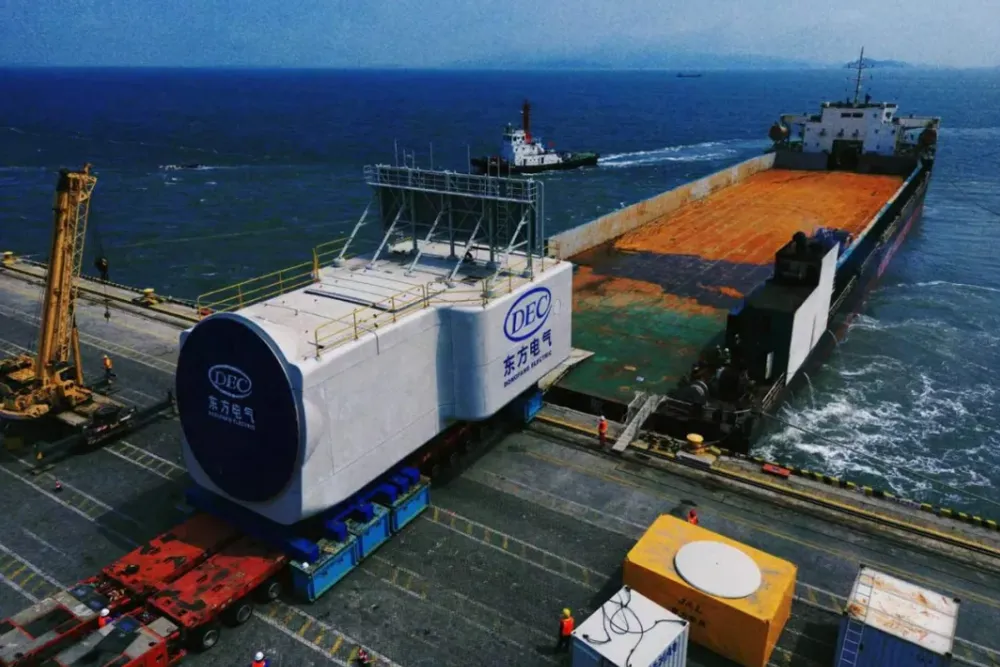Why shipping 'world's heaviest' wind turbine nacelle required a race against the tide
Transporting nacelle heavier than fully loaded Boeing 747 required using tide-synchronised roll-on method, while 153 metre blades also posed ‘extreme’ challenges

Shipping the “world’s heaviest” nacelle — a 500-tonne beast far heavier than port lifting capacity — required out of the box thinking and a race against the tide, says Dongfang Electric, as it nears installation of its 26MW prototype wind turbine.
Turbine-maker Dongfang announced yesterday that it had successfully shipped the nacelle for a giant offshore wind prototype that will be the most powerful turbine globally upon installation.
As well as the nacelle, three turbine blades – each measuring 153 metres, more than twice as long as an Airbus A380 – also made it to their destination.
The components arrived on 4 August in the Guangli Port in China’s northeastern Shandong province.
Transporting supersized components is not easy, however, and is indeed a key reason why many in the industry have argued against developing such massive turbine models in the first place.
To use another airplane comparison, the 500-tonne nacelle is comfortably heavier than a Boeing 747-400ER Freighter at its maximum take-off weight (413 tonnes). This meant it was far beyond the lifting capacity of the port, said Dongfang, which claims this is the heaviest nacelle in existence.
Faced with this issue, Dongfang said that it broke with “conventional lifting thinking” and decided to adopt a “precise tide level + high-precision roll-on/roll-off” solution.
The vessel crew remained at the port on high alert overnight waiting for a two-hour window at which the tide would be at the right level. When that window arrived, the crew moved the nacelle along a specially designed gangway at an agonisingly slow speed of less than 0.5 kilometres per hour.
The margin for error on the tide’s level was less than 10 centimetres, said Dongfang, with the crew relying on wave sensors and a dynamic balancing system.
Transporting the blades was also “extremely challenging,” said Dongfang. “The route from the factory to the port was like an obstacle course, with high-voltage power lines, bridges and sharp curves blocking the way.”
Hatching a plan to transport the blades took months of surveys, it said. The blades were transported on self-propelled modular transporter (SPMT) vehicles using a “multi-mode steering system,” allowing for diagonal moves and 360-degree rotations.
Chao Guo, a market analyst at intelligence firm TGS, said: “Dongfang Electric’s thorough preparation for this milestone transport task is evident – from advanced logistics planning to innovative solutions such as SPMT manoeuvring and tide-synchronised roll-on, all of which ensured the feasibility of the operation.”
It also “highlights the growing logistical challenges” posed by the ever-larger offshore wind components being made in China, he added.
“This mission by Dongfang Electric may help set new benchmarks for the handling and integrated transport of next-generation offshore wind components.”
With these components now in place, Dongfang said it is “nearing installation” of its 26MW prototype.
This machine will have a hub centre height of 185 metres, which Dongfang said is equivalent to a 63-storey building.
At an average annual wind speed of 10 metres per second, Dongfang said a single turbine can generate 100 million kilowatt-hours of clean electricity annually, enough to meet the annual electricity needs of 55,000 average households.
(Copyright)